A premium acetate frame is carved from a solid block of plant-based cellulose, while a mass-market plastic frame is made by injecting melted plastic into a mold. This core difference in manufacturing creates superior color depth, adjustability, and a warmer, more substantial feel, which are the hallmarks of quality that justify a higher price.
What is a Premium Acetate Frame?
Understanding the fundamental differences between premium block acetate and mass-market injection-molded plastic is the first step to making informed sourcing decisions. These materials aren’t just slightly different; they represent two entirely separate philosophies of manufacturing that directly impact the quality, durability, and perception of your brand.
At a Glance: Block Acetate vs. Injection-Molded Plastic
To make the comparison clear, let’s break down the five key differentiators you can see and feel. This table shows you why one is a premium craft material and the other is a mass-market commodity.
| Feature | Premium (Block-Cut) Acetate | Mass-Market (Injection-Molded) Plastic |
| Origin | Plant-Based (Cotton & Wood Fibers) | Petroleum-Based |
| Manufacturing | Carved from a Solid, Seasoned Block | Liquefied Plastic Poured into a Mold |
| Color | Embedded Throughout the Material | Sprayed-On Surface Layer |
| Feel | Substantial, Warm, Silky | Lightweight, Cold, Brittle |
| Adjustability | Highly Adjustable by an Optician (with heat) | Rigid and Prone to Cracking |
The Bottom Line: These are not just technical details. They are the very reasons a customer will pay more for your product. You are choosing between a crafted material and a molded commodity.
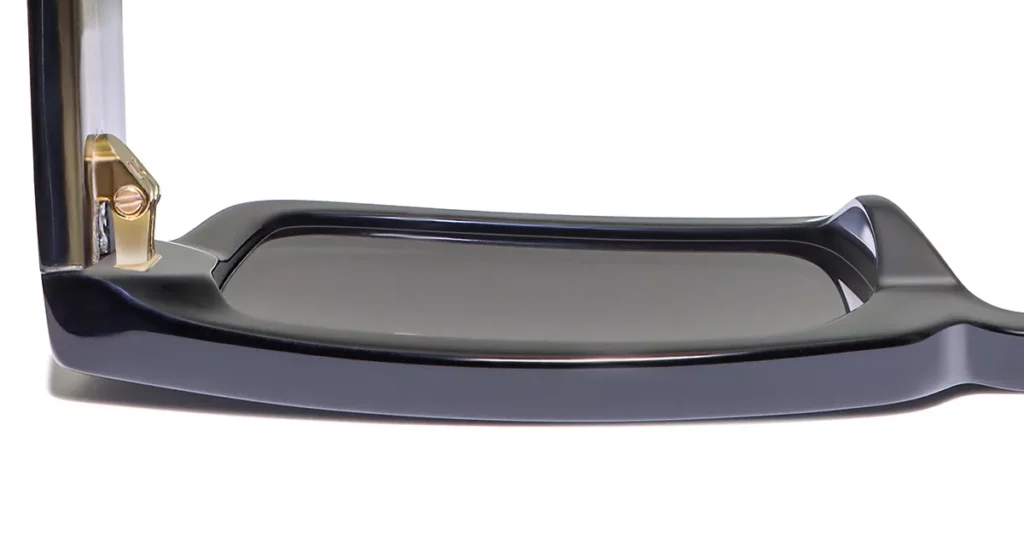
Differentiator 1: Plant-Based Origin vs. Petroleum Plastic
Premium acetate begins its life as natural cotton and wood fibers, which are formed into a cellulose paste. This means its core substance is plant-based, not petroleum-based, which offers real advantages for anyone wearing it. This is a far cry from mass-market plastic frames that rely on petroleum compounds, which often feel cold and artificial against the skin.
Most Importantly: The natural, plant-based origin of acetate makes it inherently hypoallergenic. This greatly reduces the risk of skin irritation for your customers, a common issue with cheaper, petroleum-based plastics.
Differentiator 2: The Manufacturing (Carved vs. Poured)
The production method is what truly separates these two materials. A premium acetate frame is carved from a large, solid block of seasoned material using precise machinery. In contrast, an injection-molded frame is made by squirting hot, liquefied plastic into a two-part mold. This subtractive carving process gives acetate a uniform strength that molding can’t replicate.
Differentiator 3: The Color Depth (Embedded vs. Sprayed-On)
The most visible difference is often the color depth. This means that in premium acetate, the colors and patterns are mixed directly into the raw material, creating embedded pigments that run all the way through. Think of it like a piece of marble versus a painted countertop; the pattern in the marble is integral and can’t be scratched off, while the paint is just a thin layer that can easily chip and fade over time.
Pro Tip: Always ask a potential supplier to show you a cross-section of their acetate sheets. Quality acetate will show deep, consistent color through the entire thickness of the material, proving it’s not just a surface-level coating.
Differentiator 4: The Feel (Substantial & Warm vs. Light & Brittle)
The tactile experience, or the feeling in your hand, immediately gives away the quality. Acetate has a satisfying density and a warm, silky feel that actually becomes more comfortable the longer you wear it. Injection-molded frames, on the other hand, often feel cold, hollow, and can become brittle over time, especially with exposure to sunlight.
Differentiator 5: The Adjustability (Custom Fit vs. One-Size-Fits-All)
The ability for a professional adjustment is a critical, non-negotiable feature of premium eyewear. An optician can gently heat an acetate frame and reshape the temples and bridge for a perfect, custom fit. This ensures your customer’s glasses sit properly and comfortably. Attempting to adjust a rigid, injection-molded frame often results in it snapping.
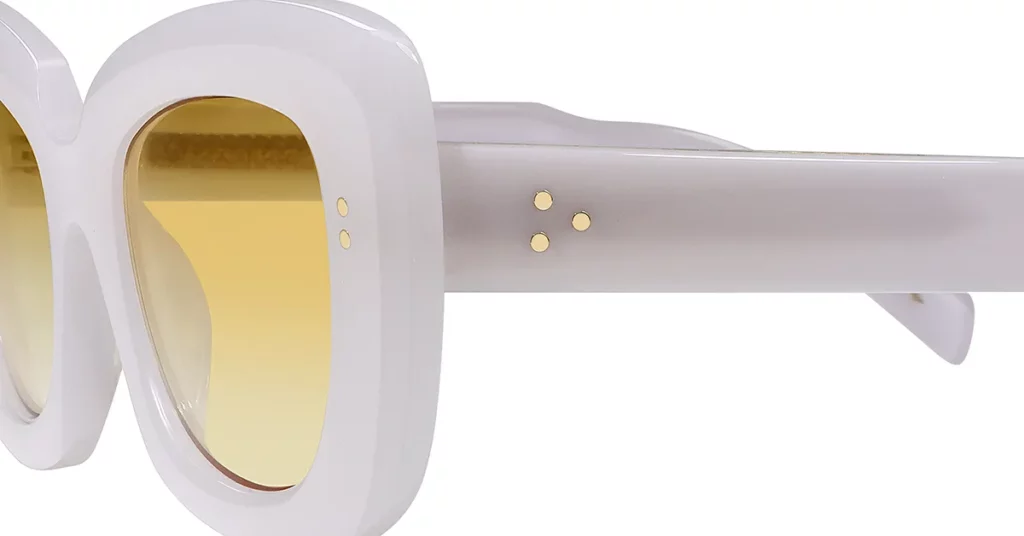
Defining “Premium” in Acetate
The word “premium” isn’t just marketing fluff; it refers to specific, measurable qualities in acetate that directly impact the frame’s performance and how your customers perceive your brand. Understanding these distinctions is how you make smart sourcing decisions.
“Premium” is Defined by Raw Material Quality
The source of the acetate itself is the foundation of quality. Materials from renowned Italian manufacturers like Mazzucchelli 1849 are the global benchmark. Their reputation comes from a century of perfecting the art of rich colors, complex patterns, and that signature premium feel. It’s a difference born from superior raw ingredients and processing techniques.
Best Practice: When you speak with suppliers, be direct and ask for the origin of their acetate sheets. While materials from Italy or Japan may have a higher cost, they provide a level of color depth and consistency that generic acetate simply cannot match.
“Premium” is Defined by the Block-Cut Process
The manufacturing method is directly tied to the frame’s durability and final quality. The gold standard is what we call the “block-cut” or sometimes “handmade” process, where each frame front is carved from a single, seasoned block of acetate. This method is the polar opposite of mass-production injection molding, which is designed for speed, not craftsmanship.
“Premium” is Defined by Time
The investment of time in curing and polishing directly translates to a better product. A single premium acetate frame can take weeks to produce, with a huge portion of that time dedicated to curing the raw material and then polishing the finished parts. This patient process ensures the material is stable and creates the deep, lustrous finish that is a hallmark of premium eyewear.
The Bottom Line: You cannot rush quality acetate manufacturing. That investment of time in proper curing and multi-stage polishing is directly responsible for the frame’s visual appeal and its ability to last for years.
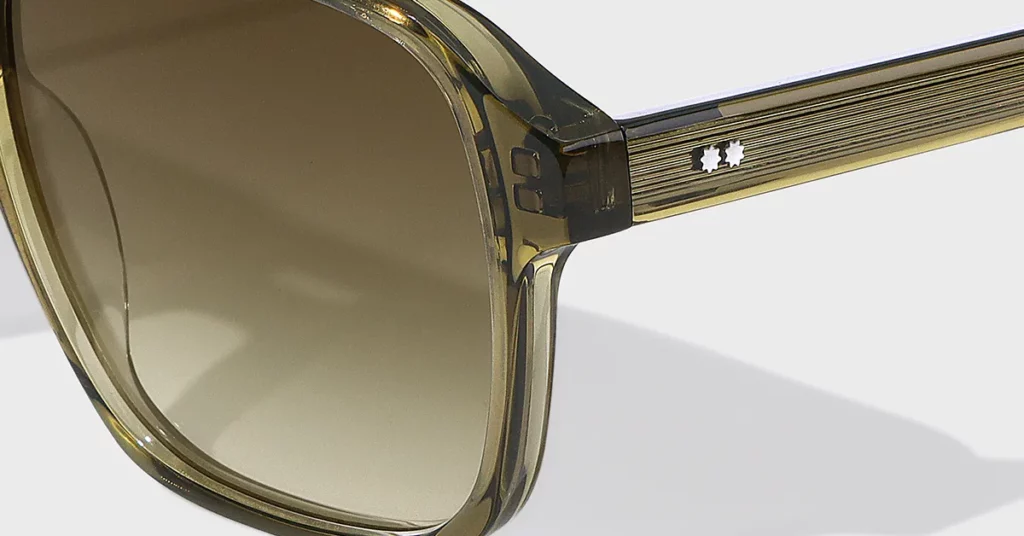
From Plant to Polish: How an Acetate Frame is Made
To truly appreciate the final product, you need to understand the journey. The process of turning raw cellulose into a polished, premium frame is a blend of material science and artisanal skill.
Stage 1: Creating the Acetate Blocks
This is where the magic of the color is born. The creation of the colored blocks determines the pattern complexity and color depth that will define the character of the finished frame.
- Step 1: Compounding Raw Cellulose: The process starts by mixing natural cotton and wood fibers with plasticizers to create a thick paste. The quality of this initial paste determines the final frame’s flexibility and strength.
- Step 2: Adding Color: To create color, powdered dyes are kneaded into the paste for a uniform look. For complex patterns like tortoiseshell or Havana, small, colored chips of acetate are layered and rolled into the base paste, creating rich, dimensional patterns.
Simple Analogy: The process is a lot like a baker making marbled dough. Different colored elements are carefully blended to create a unique pattern that runs through the entire material, ensuring no two frames are ever exactly alike.
Stage 2: Crafting the Frame from Cured Sheets
Once the colored blocks are cured, they are ready to be transformed into frame components. This requires precision and a respect for the material’s properties.
- Step 1: Slicing the Blocks: The cured blocks are sliced into sheets, typically between 4.0mm and 8.0mm thick. Thicker sheets are used for bold, statement designs, while thinner ones are perfect for more minimalist styles.
- Step 2: “Seasoning” the Sheets: Before they can be cut, the sheets are “seasoned” for weeks or even months. This critical aging process allows the material to stabilize completely, which prevents warping and ensures the final frame will hold its shape for years.
- Step 3: Cutting with CNC Machines: The frame fronts and temples are precisely cut from the seasoned sheets using computer-numerical-control (CNC) machines. This is a subtractive process—cutting away from a solid block—which maintains the material’s internal strength and preserves the flow of the embedded color patterns.
Stage 3: The Art of the Finish
The finishing process is what turns a raw-cut part into a piece of luxury. This multi-day process requires both machinery and a skilled human touch.
- The Process: Tumbling for Days: The cut components are placed in large barrels filled with wood chips and polishing pastes. They are tumbled for days, starting with larger wood chips to smooth the edges and gradually moving to smaller chips to achieve a flawless surface.
- The Human Touch: Hand-Polishing: After tumbling, every single frame is taken to a buffing wheel for hand-polishing by a skilled artisan. This final step creates the deep, even shine that machines alone cannot achieve and is a true sign of premium craftsmanship.
Remember This: The polishing process alone can take several days per frame. But this investment of time is what creates the distinctive, deep luster that allows you to identify premium acetate eyewear from across a room.
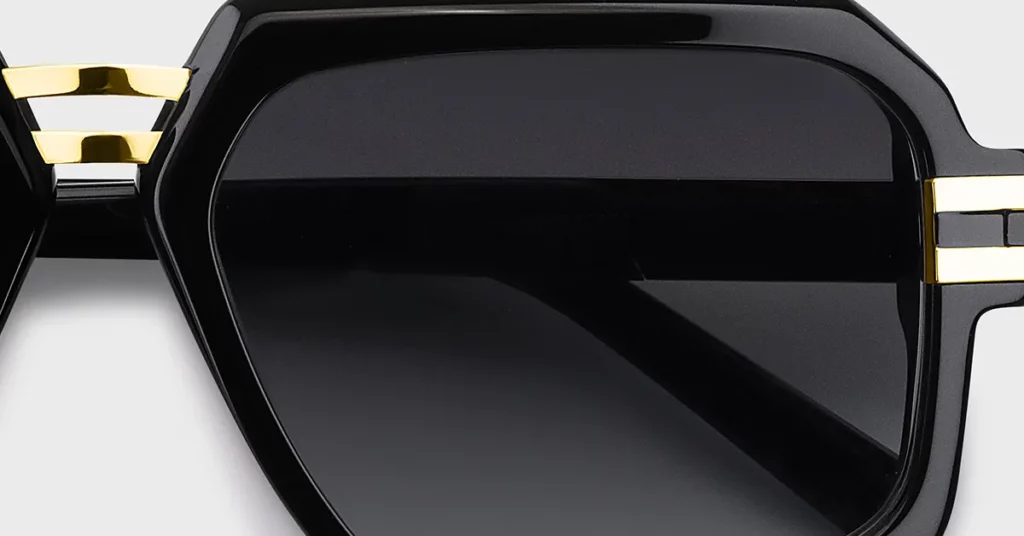
Deconstructing the Premium Frame
Now, let’s break down the individual parts of the frame. Each component tells a story about quality manufacturing and why it matters for your brand and your customer.
The Frame Front: A Showcase of Superiority
The frame front is the hero of the piece. As the largest component, it’s the main canvas for showcasing the material’s quality and the skill of the manufacturing.
- The Problem It Solves: Warping & Brittleness. Mass-market molded frames are notorious for warping and becoming brittle. This happens because the injection process creates internal stress points and inconsistent density in the plastic.
- The Premium Solution: Machined from a Solid Block. An acetate frame front is cut from a single, solid piece of seasoned acetate. This method completely eliminates the weak points and stress lines found in molded frames, ensuring consistent strength across the entire structure.
- The Benefit: Seamless Patterns. Block-cutting also allows for unique patterns, like tortoiseshell or layered colors, to flow uninterrupted across the frame front. It’s a sophisticated look that is impossible to achieve with molded or painted plastic.
The Bridge: Where Comfort and Character Meet
The bridge does more than just connect the lenses; it distributes the frame’s weight and defines its character. Acetate allows for designs that are both more comfortable and more stylish.
- The Key Style: The “Keyhole Bridge.” This iconic, vintage style is designed to rest on the sides of the nose, not the top. This detail requires precise machining to get the shape right while maintaining strength, making it a hallmark of premium construction.
- The Premium Difference: Sculpted, Not Assembled. In an acetate frame, the bridge is sculpted as part of the frame front, creating a seamless and much stronger structure. There are no glue points or weak joints, just one solid, gracefully contoured piece.

The Temples: The Engine of Durability
Temple construction is where premium acetate truly proves its superiority over cheaper alternatives. The key is something you can’t always see: the wire core.
- The Problem It Solves: Flimsy, Breaking Arms. We’ve all seen cheap frames with flimsy arms that snap easily. This is because they are nothing more than simple plastic extrusions with no internal support.
- What It Is: The Reinforced Wire Core. The secret to strong yet flexible temples is the wire core. This is a metal wire, typically made of nickel silver or titanium, that is heated and permanently shot through the center of theacetate arm.
- The Functional Benefit: Rigidity and a Custom Fit. This provides the crucial internal skeleton that prevents the temple from easily snapping, while also giving it the ‘memory’ needed for a perfect, custom fit that lasts. An optician can heat and bend the temple, and the wire core holds that new shape.
Quality Marker: On translucent acetate frames, you can often see the elegant wire core running through the temple. Don’t see this as a flaw; it’s a beautiful hallmark of high-quality construction.
The Hinges: The Point of Connection
Hinges are the most mechanically stressed part of any frame. The quality of the hinge and how it’s attached is a dead giveaway of the frame’s overall quality.
- The Problem It Solves: Loose, Wobbly Connections. Cheap frames use simple hinges that are often just melted into the plastic. With use, these connections inevitably loosen, creating that dreaded “wobble” or failing completely.
- The Premium Solution: Multi-Barrel Hinges with Rivets. You need to look closely at the multi-barrel hinges. Premium frames use 5 or 7 interlocking barrels, which means the force of opening and closing is spread across a much wider area. Think of it like the difference between a standard door hinge and a heavy-duty bank vault hinge—more interlocking parts create a connection that is vastly more durable.
- Quality Marker: Real, Anchoring Rivets. Critically, these high-quality hinges are anchored to the frame with rivets that pass all the way through the acetate. This creates a physical, mechanical bond that will not pull out or loosen over time.
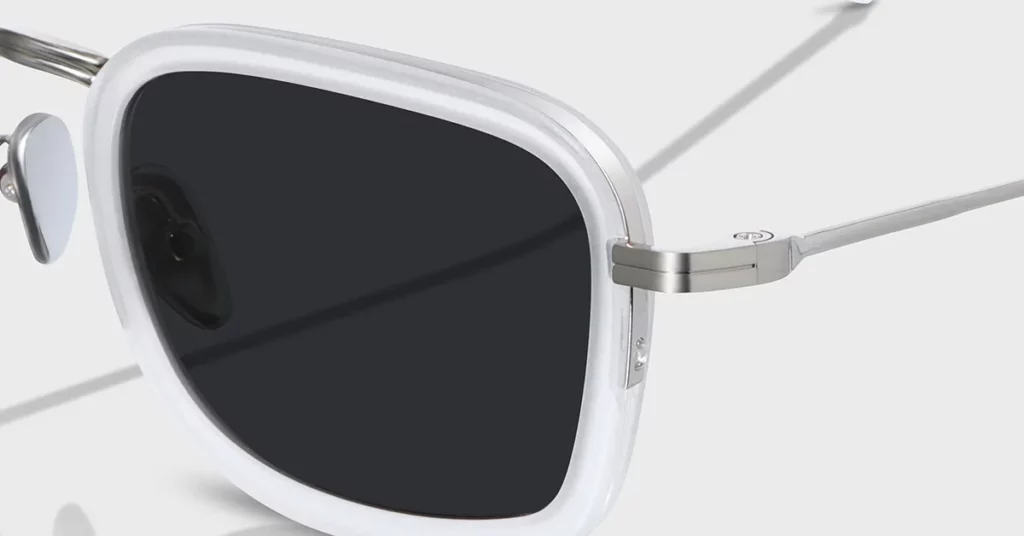
A Brand Builder’s Guide to Acetate Variations
Not all acetate is the same. Understanding the different types allows you to make strategic choices that align with your brand’s story and your customers’ needs.
| Acetate Type | Key Characteristic | Best For | Brand Story |
| Standard Acetate | Classic, thick, and bold (4-8mm) | Heritage looks, statement pieces | Emphasizes craftsmanship and bold design confidence. |
| High-Density Acetate | Thin, light, yet very strong (1.5-3.5mm) | Minimalist, modern, tech-focused lines | Appeals to customers who value sleek aesthetics and technical performance. |
| Bio-Acetate | Eco-friendly with plant-based plasticizers | Any style, for sustainability-focused brands | Delivers an authentic sustainability message without compromising on premium quality. |
The Bottom Line: Your material choice is a core part of your brand strategy. Whether you choose Standard Acetate for a heritage feel, High-Density for a modern line, or Bio-Acetate for an eco-conscious collection, your choice tells a powerful story.
How to Spot a Genuinely Premium Frame
Use this simple checklist to protect your brand and ensure you are sourcing, and selling, genuine quality. These are the details that separate true craftsmanship from a convincing fake.
- Signal #1: Deep, Integral Color. Look at the color on the edges and inside the frame. The color should be just as rich and deep as it is on the front. A flat, painted-on look is a red flag.
- Signal #2: The Absence of Mold Lines. Inspect the frame carefully, especially around the edges. A premium, block-cut frame will have no thin seams or parting lines, which are always present on injection-molded products.
- Signal #3: A Visible Wire Core. In any remotely translucent frame, look for the metal wire core inside the temples. Its presence is a clear sign of quality construction.
- Signal #4: Robust Hinges with Real Rivets. Count the barrels on the hinge (look for 5 or 7) and check that the hinge is attached with small, round metal rivets that go through the acetate, not just pressed into the surface.
- Signal #5: A Deep, Hand-Buffed Luster. The shine on the frame should feel deep and rich, not like a cheap, glossy topcoat. A hand-buffed finish has a warmth and luster that can’t be replicated by a simple spray.
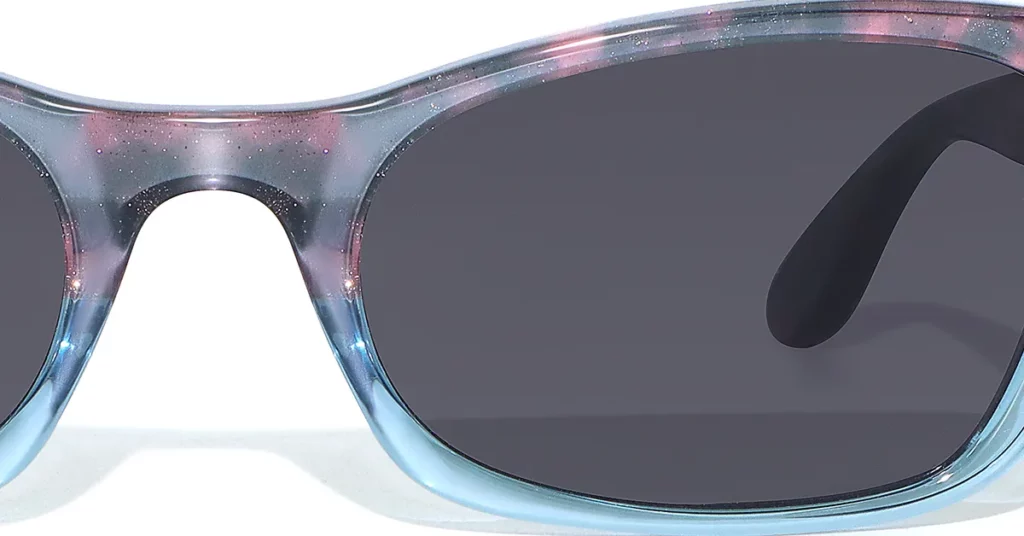
Proper Care for Long-Lasting Quality
Premium frames are an investment. Educating your customers on proper care protects that investment and reinforces the value of their purchase.
The Do’s of Acetate Care
- Do: Clean with lukewarm water and a drop of mild dish soap.
- Do: Always use a clean, soft microfiber cloth for drying and polishing.
- Do: Store the frames in their protective case when not in use.
The Don’ts of Acetate Care
- Don’t: Leave frames in a hot car, as the heat can cause them to warp.
- Don’t: Use alcohol, acetone, or other harsh chemical cleaners on the frame.
- Don’t: Lay your glasses lens-down on any surface.
Conclusion
Understanding the anatomy of an acetate frame gives your brand a superpower. It allows you to connect the physical attributes of the product directly to your marketing story, giving you a powerful way to justify a premium price. This knowledge empowers you to have more informed conversations with your manufacturing partners and, most importantly, to deliver on the promise of quality that your customers expect and deserve.
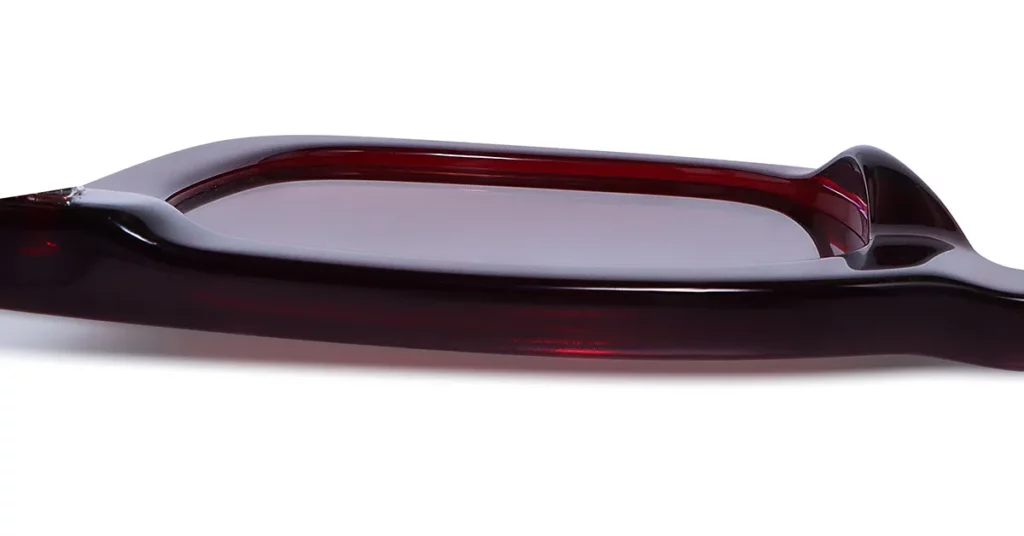
Frequently Asked Questions
1. Why are acetate frames more expensive than regular plastic ones?
Acetate frames cost more due to the time and craftsmanship required. The process involves carving from solid blocks, long curing times, and extensive multi-stage hand-polishing, which is far more resource-intensive than quickly injection-molding a plastic frame.
2. Is “handmade” acetate really made entirely by hand?
While modern CNC machines are used for precise cutting, critical stages like final polishing, assembly, and quality control are done by hand. The term refers to the high level of artisanal skill and attention to detail involved, not a complete absence of machinery.
3. What does the metal bar inside the temple do?
That metal wire core is essential. It provides internal strength to prevent breakage while also giving the temple the rigidity and memory needed for an optician to perform a custom, lasting fit adjustment.
4. What is the white film on old acetate frames?
That white film is usually plasticizer that has migrated to the surface over time. In most cases, this can be polished away by an optician, restoring the frame’s original luster and color.
5. Can an optician adjust my acetate frames to fit better?
Absolutely. Acetate’s ability to be adjusted with gentle heat is one of its key premium features. A skilled optician can reshape the temples and bridge to create a perfect, comfortable fit for your specific facial features.

